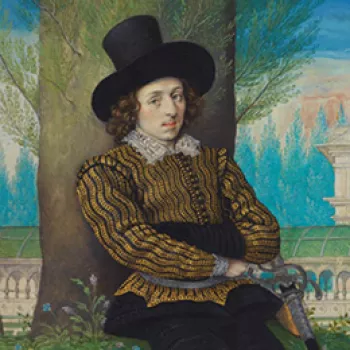A rustic hut c.1759
Pencil, pen and ink and watercolour | 50.0 x 35.4 cm (sheet of paper) | RCIN 924812

Sir William Chambers (1722-96)
A rustic hut c.1759

Sir William Chambers (1722-96)
A rustic hut c.1759


-
Elevation of a hut, with tree trunks supporting a pediment made of branches and other 'natural' elements. An illustration to The Origins of Buildings and Orders. To the scale 2 2/8": 5'.
The architect William Chambers was the key architectural influence and adviser to the King for almost fifty years. He appears to have been introduced to the royal family in 1749, in connection with Frederick, Prince of Wales’s new garden at Kew. Eight years later - after receiving a thorough professional training in both Paris and Italy - he was appointed Architect to the widowed Princess of Wales and at the same time he became architectural tutor to her eldest son, the future George III. The government department in charge of royal buildings was the Office of Works, where Chambers progressed from the position (from 1761) of one of the two Joint Architects (with Robert Adam) to Comptroller of the Works (from 1769); finally - from 1782 - he was the first holder of the new combined office of Surveyor-General and Comptroller. He was thus able to serve the King’s interests very directly. Chambers was also a crucial figure in the early years of the Royal Academy, founded in 1768: he drafted the foundation document, was appointed the Academy’s first Treasurer, and served as a crucial liaison between the Academy and the crown. Although Reynolds was President, he was aware that ‘Sir William was Viceroy over him’. Chambers is shown between Reynolds and the Secretary, F.M. Newton, to left of centre in Zoffany’s painting of the Academicians (Royal Collection). Throughout his life Chambers retained strong links with Sweden, where he was born. In 1770 he was made Knight of the Order of the Polar Star by Gustavus III of Sweden. After initial hesitation, he was permitted by George III to be addressed as ‘Sir William’ in England.
The freedom and delicacy of the handling of the wash and the depiction of the climbing foliage in this drawing are reminders of the skills and techniques of draughtsmanship learnt by Chambers in Paris and Rome.
Catalogue entry adapted from George III & Queen Charlotte: Patronage, Collecting and Court Taste, London, 2004Provenance
Drawn for George III
-
Creator(s)
(draughtsman) -
Medium and techniques
Pencil, pen and ink and watercolour
Measurements
50.0 x 35.4 cm (sheet of paper)
Other number(s)
RL 24812








